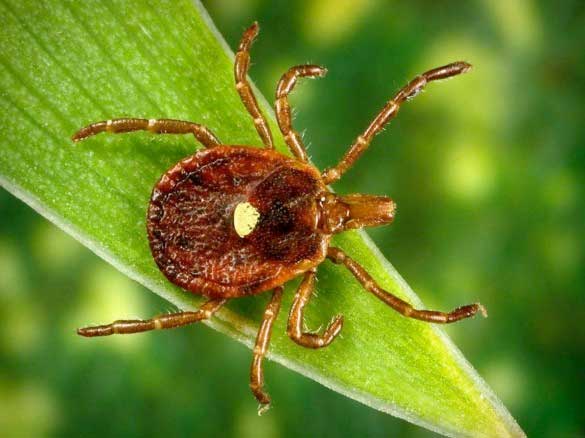LONE STAR TICK
(Amblyomma americanum)
Tick season is just beginning, with the warm season months starting. The first tick that is usually noticed by home owners in central NC and is over looked by the public is the lone star tick. It is very widespread in America ranging from Maine to Florida and as far west to Texas and Iowa.
Like all ticks there development stages are egg, larva, nymph, and adult. After the egg is hatched the tick must take a blood meal to complete each stage of its life cycle. Do to the fact that ticks feed on a living host they may transmit germs, which could have serious consequences for humans.
There are several diseases the lone star tick transmits: human monocytotropic ehrlichiosis, canine and human granulocytic ehrlichiosis, tularemia, and the one most people should be aware of southern tick-associated rash illness (STARI). STARI exhibits a rash similar to that caused by Lyme disease, but is considered less severe. That’s why it’s very important to keep the tick when you are bitten, because the treatment will be much different let’s say if you got bit by a deer tick that causes the same rash. With STARI the rash is accompanied by headache, fever, fatigue, and muscle pains. This disease has not been linked to arthritis, neurological disease, or chronic symptoms. The biggest concern of lone star ticks there bites can cause a person to develop a meat allergy to non primate mammalian meat and meat products. The allergic reaction can take from a day to 2 weeks to show up, and can in some cases be permanant, just imagine not being to eat a hamburger or steak ever again. As a rule of thumb a tick has to be attached on you feeding at least 6 hours in order to transmit diseases.
So you ask what I should do to protect myself from ticks:
- Avoid overgrown weedy paths, layer your clothing, and tuck your pant legs into your socks and shirttails in your pants. Wear light colored clothes so it’s easier to see them.
- Insect repellents are effective.
- Self inspect yourself before you shower and before you go to bed.
- Blood testing for antibodies can take up to several weeks; symptoms are more likely to develop before you can get an accurate test. Saving and identifying the tick can let physicians know what to treat for.
- Inspect your pets frequently, they can transport ticks to the living areas. Have your pet prevent ably treated by a veterinarian.
Controlling ticks around your home and public use areas (keep grass mowed to discourage rodent’s hosts, remove leaf litter, and apply pesticides.


